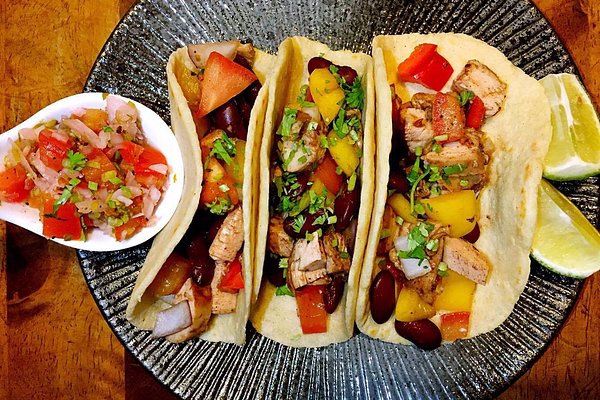Global Street Food: Exploring Tacos from Mexico to California

Street food is an essential part of the global culinary landscape, offering a flavorful and authentic taste of local culture. One street food that has transcended borders and evolved into an international sensation is the taco. From its humble beginnings in Mexico to its reinvention in California, tacos have become a beloved dish worldwide. In this blog, we’ll take you on a journey through the history, regional variations, and global adaptations of tacos, highlighting how this simple yet versatile dish continues to captivate taste buds everywhere.
The Origins of Tacos: A Taste of Mexico
Tacos are a quintessential Mexican street food, deeply embedded in the country’s culinary heritage. While the exact origin of the taco is debated, it’s widely believed that tacos have been around since the early 1900s. The word “taco” itself is derived from the Spanish word for “plug” or “wedge,” referring to the way a taco can be filled with a variety of ingredients, from meats and vegetables to salsa and cheese.
Traditionally, tacos in Mexico are made with soft, warm corn tortillas filled with simple, flavorful ingredients. Common fillings include grilled meats like carnitas (slow-cooked pork), al pastor (marinated pork cooked on a vertical spit), and beef or chicken, often accompanied by fresh toppings such as cilantro, onions, and a squeeze of lime. Salsas made from tomatoes, chilies, and other fresh ingredients provide a zesty kick that elevates the flavors.
In Mexican street food culture, tacos are a quick, affordable meal that can be eaten at any time of day. Street vendors, or “taqueros,” are the lifeblood of taco culture, serving up fresh, piping-hot tacos to locals and visitors alike. Whether you’re wandering the streets of Mexico City or a small village in Oaxaca, tacos are an ever-present and comforting part of everyday life.
Regional Variations Across Mexico
While the concept of tacos remains consistent across Mexico, each region puts its own twist on the dish, resulting in unique variations.
1. Tacos al Pastor (Mexico City):
Tacos al pastor are one of the most iconic tacos in Mexico. Originating from the Lebanese immigrants in Mexico City, al pastor features marinated pork cooked on a vertical rotisserie, similar to shawarma. The pork is typically topped with pineapple and served on a corn tortilla with cilantro, onions, and salsa.
2. Tacos de Carnitas (Michocán):
Carnitas, meaning “little meats,” are a staple in Michoacán, where the slow-cooked pork is simmered in lard until tender and crispy. These tacos are often paired with a variety of salsas, pickled vegetables, and a squeeze of lime.
3. Tacos de Barbacoa (Central Mexico):
Barbacoa refers to meat, often lamb or goat, slow-cooked in an underground pit. The result is tender, flavorful meat that’s perfect for stuffing into a soft tortilla. This dish is especially popular for special occasions like weekends and holidays.
4. Tacos de Pescado (Baja California):
In coastal regions like Baja California, seafood takes center stage. Tacos de pescado (fish tacos) are a fresh, light variation featuring battered or grilled fish, often topped with cabbage slaw and a creamy sauce.
These regional variations highlight how the taco has adapted to local ingredients, traditions, and tastes across Mexico, making it a versatile and beloved dish.
Tacos in California: The Birth of the “California Taco”
When tacos made their way to the United States, particularly California, they underwent a major transformation. California’s proximity to Mexico made it an ideal location for tacos to thrive, but it was the state’s diverse food culture that allowed tacos to evolve in exciting new directions.
The Mexican-American community in California began selling tacos on street corners, introducing the dish to a broader audience. But it wasn’t until the 1960s and 1970s that the “California taco” truly began to take shape. Tacos in California started to include a wider range of ingredients, reflecting the region’s culinary diversity and emphasis on fresh, locally sourced food.
One of the most famous examples of the California taco is the fish taco, a dish popularized by Baja California immigrants in Southern California. The light, crispy fish, often paired with tangy cabbage slaw and avocado, became an instant hit, especially in coastal cities like San Diego and Los Angeles.
1. The Crunchy Taco (Taco Bell):
The emergence of Taco Bell in the 1960s introduced the American public to the crispy, hard-shell taco, which quickly became a fast-food staple. The crunchy taco was a departure from the soft corn tortillas commonly used in Mexico but has become synonymous with the taco experience in the U.S.
2. Fusion Tacos:
California’s multicultural influence has also led to the rise of fusion tacos that blend different cuisines. One popular example is the Korean BBQ taco, which combines grilled beef (often bulgogi) with kimchi, spicy mayo, and cilantro in a soft corn tortilla. These inventive taco combinations reflect California’s innovative culinary spirit and love for fusion dishes.
3. Vegetarian and Vegan Tacos:
In California, there’s also been a surge in plant-based tacos. Restaurants and food trucks offer a variety of vegetarian and vegan options, such as tacos filled with grilled vegetables, tofu, or jackfruit, along with creative toppings like avocado, vegan sour cream, and salsa verde.
The Global Taco Movement
The popularity of tacos has spread far beyond California and Mexico, influencing street food scenes around the world. In major cities like New York, London, and Tokyo, tacos are becoming a common feature in both traditional Mexican eateries and innovative food trucks.
In many parts of the world, local flavors are being incorporated into taco fillings, creating global variations that still retain the spirit of the original. For example, in South Korea, tacos are filled with bulgogi beef, while in Australia, tacos may feature unique ingredients like kangaroo meat or pickled beets.
Conclusion: Tacos Unite the World
From the bustling streets of Mexico City to the innovative taco trucks of California, tacos have evolved from a humble street food to a global sensation. They are a testament to the versatility and adaptability of food, capable of absorbing influences from all over the world while maintaining their core identity. Whether you prefer the traditional simplicity of a taco de carnitas or the creative explosion of a Korean BBQ taco, there’s no denying that tacos are a universal food that brings people together.
So the next time you take a bite of your favorite taco, remember that you’re enjoying a dish with a rich history, cultural significance, and an exciting future as it continues to spread across the globe.
Happy taco exploring!



